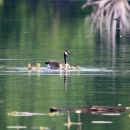About Us
Chickasaw National Wildlife Refuge was established in 1985. It has the largest tract of bottomland hardwood forest in Tennessee, and lies in the Lower Mississippi River floodplain. Eight miles of the refuge’s western boundary adjoins the Mississippi River. The refuge gets its name from the Chickasaw Indians, who historically occupied portions of west Tennessee, including Lauderdale County in which the refuge is located.
Habitats found on the refuge include; 39 acres of open administrative land; 1,256 acres of agriculture and moist-soil open land (the agriculture/moist-soil ratio varies from year to year); 777 acres of bald cypress/tupelo forest; 5,719 acres of mixed bottomland hardwood forest; 89 acres of grassland; 119 acres of open water; 373 acres of sandbar; 32 acres of scrub/shrub; and 1,047 acres of upland forest. The Sunk Lake Public Use Natural Area includes three acres of administrative lands; 274 acres of bald cypress/tupelo forest; 1,466 acres of mixed bottomland hardwood forests; and 130 acres of open water. The total current deeded acreage managed in the Lower Hatchie Refuge is 9,451 acres. The Sunk Lake Public Use Natural Area includes a total of 1,873 acres.
Our Mission
Chickasaw National Wildlife Refuge was authorized by the Migratory Bird Conservation Act of 1929 for “... use as an inviolate sanctuary, or for any other management purpose, for migratory birds.”
Other Facilities in this Complex
Chickasaw National Wildlife Refuge is managed as part of the West Tennessee National Wildlife Refuge Complex.



